Using Retrofit 2, you could do this:
//Lets Suppose this you have this postman or you want to make some request like this

//ServiceCreator (In my case i am using oauth2 so have AccessToken). This is a working and production sample, so you have to make your own changes, but i attach to example all components.
public class APIRestClient {
public static String API_BASE_URL = "http://186.151.238.14/";
private static OkHttpClient.Builder httpClient;
private static Retrofit.Builder builder;
public static Retrofit retrofit;
private static Activity mActivity;
private static AccessToken mToken;
/**
* setupBase URL
* @param _baseActivity
*/
public static void setupBaseUrl(Context _baseActivity){
String tmpBase = SharedPreferenceUtilities.getDomain(_baseActivity);
if (tmpBase != null && tmpBase.length() > 0){
if (tmpBase != API_BASE_URL) {
APIRestClient.API_BASE_URL = tmpBase;
}
}
}
/**
* auth2 Authorization Bearer...token create Service instance
* @param _serviceClass
* @param _baseActivity
* @param <S>
* @return
*/
public static <S> S createService(Class<S> _serviceClass, final Activity _baseActivity) {
AccessToken accessToken = TaskManagementApplication.getInstance().getAccessToken();
if (_baseActivity != null) {
setupBaseUrl(_baseActivity);
}
httpClient = new OkHttpClient.Builder();
httpClient.connectTimeout(30000, TimeUnit.SECONDS)
.readTimeout(30000,TimeUnit.SECONDS);
if (BuildConfig.DEBUG) {
HttpLoggingInterceptor logging = new HttpLoggingInterceptor();
logging.setLevel(HttpLoggingInterceptor.Level.BODY);
httpClient.addInterceptor(logging);
httpClient.addNetworkInterceptor(new StethoInterceptor());
}
builder = new Retrofit.Builder()
.baseUrl(API_BASE_URL)
.addConverterFactory(GsonConverterFactory.create());
if (accessToken == null){
accessToken = new AccessToken();
accessToken.setAccessToken("");
accessToken.setTokenType("Bearer");
accessToken.setScope("");
accessToken.setRefreshToken("");
accessToken.setClientID("");
accessToken.setClientSecret("");
accessToken.setExpiry(0);
}
if(accessToken != null) {
mActivity = _baseActivity;
mToken = accessToken;
final AccessToken token = accessToken;
httpClient.addInterceptor(new Interceptor() {
@Override
public Response intercept(Chain chain) throws IOException {
Request original = chain.request();
Request.Builder requestBuilder = original.newBuilder()
.header("Accept", "application/json")
.header("Content-type", "application/json")
.header("Authorization",
token.getTokenType() + " " + token.getAccessToken())
.method(original.method(), original.body());
Request request = requestBuilder.build();
return chain.proceed(request);
}
});
httpClient.authenticator(new Authenticator() {
@Override
public Request authenticate(Route route, Response response) throws IOException {
if(responseCount(response) >= 2) {
// If both the original call and the call with refreshed token failed,
// it will probably keep failing, so don't try again.
LoginUtilities.initLogin(_baseActivity,LoginActivity.LOGININTENTRESULT,null);
return null;
}
// We need a new client, since we don't want to make another call using our client with access token
OAuthInterface tokenClient = createAuthService(OAuthInterface.class,mActivity);
Call<AccessToken> call = tokenClient.getRefreshAccessToken(
Grant_type.REFRESH_TOKEN.toString(),
token.getRefreshToken(),
StringUtilities.API_OAUTH_CLIENTID(_baseActivity),
StringUtilities.API_OAUTH_SECRET(_baseActivity),
"");
try {
retrofit2.Response<AccessToken> tokenResponse = call.execute();
if(tokenResponse.code() == 200) {
AccessToken newToken = tokenResponse.body();
mToken = newToken;
SharedPreferenceUtilities.setAccessToken(mActivity,mToken);
TaskManagementApplication.getInstance().setupToken(mToken);
return response.request().newBuilder()
.header("Authorization", newToken.getTokenType() + " " + newToken.getAccessToken())
.build();
} else {
LoginUtilities.initLogin(_baseActivity,LoginActivity.LOGININTENTRESULT,null);
return null;
}
} catch(IOException e) {
LoginUtilities.initLogin(_baseActivity,LoginActivity.LOGININTENTRESULT,null);
return null;
}
}
});
}
OkHttpClient client = httpClient.build();
Retrofit retrofit = builder.client(client).build();
return retrofit.create(_serviceClass);
}
/**
* not auth create Service instance
* @param _serviceClass
* @param _context
* @param <S>
* @return
*/
private static int responseCount(Response response) {
int result = 1;
while ((response = response.priorResponse()) != null) {
result++;
}
return result;
}
}
//ApiInterface
public interface StudentInterface
{
public static final String ENVIARTAREAAPI = "api/estudiante/entregatarea";
@Multipart
@POST(ENVIARTAREAAPI)
Call<TareaCalificacion> entregatarea(@Part("Descripcion") RequestBody Descripcion,
@Part("IdTarea") RequestBody IdTarea,
@Part("IdEstudiante") RequestBody IdEstudiante);
}
//ApiCall (in your activity, fragment or wetheaver) this should be used when you execute your api call
RequestBody descripcionRequestBody = RequestBody.create(
okhttp3.MediaType.parse("text/plain; charset=utf-8"),
mensageEntregaTmp);
RequestBody idTareaRequestBody = RequestBody.create(
okhttp3.MediaType.parse("text/plain; charset=utf-8"),
String.valueOf(mTarea.getIdTarea()));
RequestBody idEstudianteRequestBody = RequestBody.create(
okhttp3.MediaType.parse("text/plain; charset=utf-8"),
String.valueOf(currUser.getPerfil().getSisId()));
StudentInterface studentInterface = APIRestClient.createService(StudentInterface.class,DetalleTareaActivity.this);
Call<TareaCalificacion> call = studentInterface.entregatarea(
descripcionRequestBody,
idTareaRequestBody,
idEstudianteRequestBody);
call.enqueue(new Callback<TareaCalificacion>() {
@Override
public void onResponse(Call<TareaCalificacion> call, Response<TareaCalificacion> response) {
int statusCode = response.code();
if(statusCode == 200) {
Toast.makeText(getApplicationContext, "Success Request", Toast.LENGTH_SHORT).show();
} else {
//todo some kind of error
}
}
@Override
public void onFailure(Call<TareaCalificacion> call, Throwable t) {
//todo some kind of error
}
});
I have used this to upload photos, so i have to use this sample to do that, thats the reason i did not use Content Type application/json.
Hope that helps how to do.
Some class (pojo) like TareaCalificacion (that is what i expect from the response are just class, that i use with GSON), so TareaCalificacion.java is like:
public class TareaCalificacion {
@SerializedName("sisId")
@Expose
private long sisId;
@SerializedName("sisDescripcion")
@Expose
private String sisDescripcion;
@SerializedName("sisEstado")
@Expose
private String sisEstado;
@SerializedName("sis")
@Expose
private int sis;
@SerializedName("sisUsuario")
@Expose
private String sisUsuario;
@SerializedName("CalificacionObtenida")
@Expose
private double CalificacionObtenida;
@SerializedName("IdEstudiante")
@Expose
private long IdEstudiante;
@SerializedName("IdTarea")
@Expose
private long IdTarea;
@SerializedName("Adjunto")
@Expose
private int Adjunto;
@SerializedName("ObservacionCalificacion")
@Expose
private String ObservacionCalificacion;
@SerializedName("IdCatedratico")
@Expose
private long IdCatedratico;
public TareaCalificacion() {
}
}
Attach some links that could help you if you have doubts:
Retrofit Documentation
Another example using this
Lets me know if that works or if is not clear how to do
Regards.
